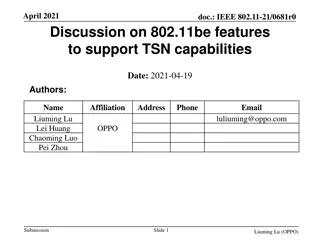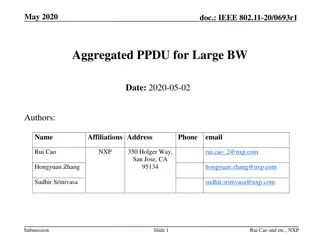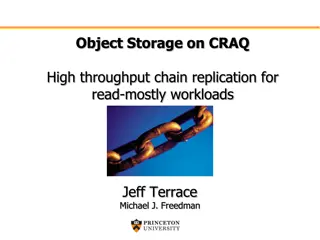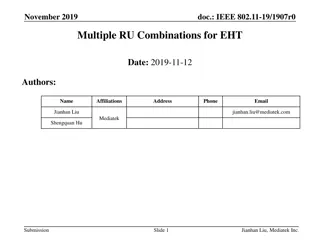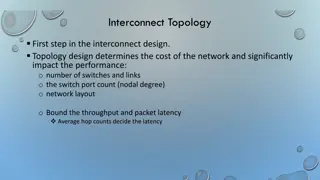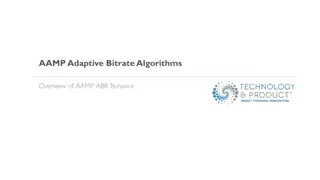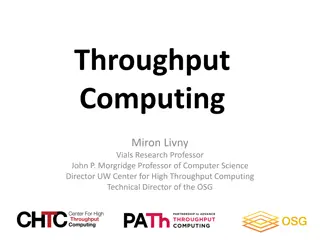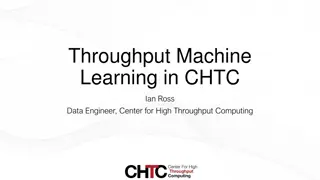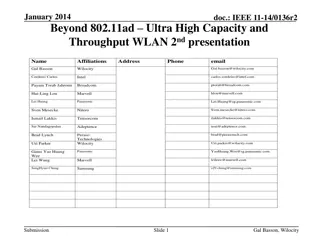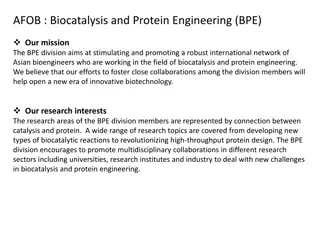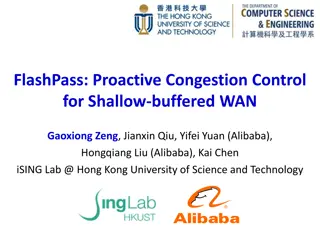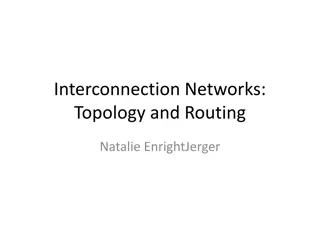Tan Cang Haiphong International Container Terminal Overview
Tan Cang Haiphong International Container Terminal welcomes the delegation from Regional Container Lines in May 2023. The terminal is the first deep-water container terminal in Northern Vietnam, facilitating trade and container throughput. Explore information about Vietnam's GDP growth, internationa
2 views • 20 slides
Modeling and Generation of Realistic Network Activity Using Non-Negative Matrix Factorization
The GHOST project focuses on the challenges of modeling, analyzing, and generating patterns of network activity. By utilizing Non-Negative Matrix Factorization (NMF), realistic network activity patterns can be created and injected into live wireless networks. Understanding and predicting user behavi
4 views • 28 slides
Network Function Abstraction A delicate question of (CPU) affinity?
Exploring the delicate balance of CPU affinity in network function abstraction, including challenges, benefits, and solutions like CPU pinning for network workloads. Learn about the impact on performance and scalability, as well as the importance of proper configuration in virtual and physical envir
3 views • 40 slides
Channel Information Feedback Enhancement for Improved Beamforming Performance
Beamforming plays a crucial role in achieving high throughput in wireless networks, but issues with discontinuity in beamforming lead to performance limitations. This document discusses the challenges with current beamforming practices and proposes a solution by increasing feedback overhead to enhan
2 views • 17 slides
Transformative Power of Sequencing in Molecular Biology
The falling costs of sequencing have revolutionized various fields like genetics, genomics, cell biology, microbiology, and evolutionary biology. Sequencing data has enabled us to understand genomes, revolutionize cell biology techniques, conduct comparative genomics, population genomics, and metage
1 views • 31 slides
Evolution of Wi-Fi and Cellular Technologies for Next Generation
The document discusses the initiation of a new study group for the next generation of Wi-Fi following IEEE 802.11be, emphasizing objectives like deterministic operation, increased throughput, and capacity. It outlines a timeline for the launch of new mainstream PHY/MAC generations every four years.
6 views • 12 slides
Discussion on IEEE 802.11be Features for TSN Capabilities
IEEE 802.11be introduces features to support Time-Sensitive Networking (TSN) capabilities by enhancing throughput, traffic delivery paths, scheduling flexibility, and latency reduction. The standard addresses the stringent latency requirements of real-time applications, medium access protection, mul
1 views • 10 slides
Network Compression Techniques: Overview and Practical Issues
Various network compression techniques such as network pruning, knowledge distillation, and parameter quantization are discussed in this content. The importance of pruning redundant weights and neurons in over-parameterized networks is highlighted. Practical issues like weight pruning and neuron pru
0 views • 37 slides
Network Slicing with OAI 5G CN Workshop Overview
Overview of Network Slicing with OAI 5G CN workshop focusing on the crucial role of network slicing in realizing the service-oriented 5G vision. This workshop covers topics like multiple logical networks creation on shared infrastructure, different types of network slices, preparation and instantiat
1 views • 6 slides
High-Throughput True Random Number Generation Using QUAC-TRNG
DRAM-based QUAC-TRNG provides high-throughput and low-latency true random number generation by utilizing commodity DRAM devices. By employing Quadruple Row Activation (QUAC), this method outperforms existing TRNGs, achieving a 15.08x improvement in throughput and passing all 15 NIST randomness tests
0 views • 10 slides
Enhancing Network Performance with RoCE Technology
Remote Direct Memory Access (RDMA) benefits, RoCEv2 packet format, resilient RoCE feature progression, optimizing network performance with QoS, and RoCE congestion control convergence analysis are discussed in this proposal. RoCE technology offers low latency, high throughput, and efficient CPU usag
0 views • 19 slides
Understanding Azure Cosmos DB Billing Components and Request Units
Azure Cosmos DB billing model consists of two main components - Consumed Storage and Provisioned Throughput. You are billed based on the storage consumption and provisioned throughput. Request Units (RUs) abstract physical resources for performing requests, with specific RU costs for different types
0 views • 13 slides
Understanding Snort: An Open-Source Network Intrusion Detection System
Snort is an open-source Network Intrusion Detection System (NIDS) developed by Cisco, capable of analyzing network packets to identify suspicious activities. It can function as a packet sniffer, packet logger, or a full-fledged intrusion prevention system. By monitoring and matching network activity
0 views • 23 slides
Enhancing Throughput with Aggregated PPDU for Large Bandwidth IEEE 802.11 Networks
This document discusses the implementation of Aggregated PPDU to boost throughput in IEEE 802.11 networks with large bandwidth. The focus is on accommodating various STAs with different operating bandwidths and optimizing traffic flow. By utilizing Aggregated PPDU, significant gains in throughput ca
5 views • 7 slides
Understanding Chain Replication for High Throughput Object Storage
Chain replication is a technique used to achieve high throughput and scalability in object storage systems. It ensures strong consistency by maintaining replicas of data across a chain of nodes, enabling efficient read-mostly workloads. The approach simplifies programming complexity and enhances sys
0 views • 28 slides
Multiple RU Combinations for Enhanced High Throughput (EHT) in IEEE 802.11-19/1907r0
The document discusses the introduction and design principles for multiple RU combinations in the context of IEEE 802.11-19/1907r0. It explores the considerations and useful scenarios of small-size RU combinations within specified bandwidths, emphasizing the efficiency and complexity balance in the
0 views • 19 slides
Evaluation Metrics for IEEE 802.11-14/0107 HEW Proposal
Evaluation metrics play a crucial role in assessing WLAN system performance and achieving the objectives of High Efficiency WLAN (HEW). This proposal by Yonggang Fang et al. from ZTE outlines the key evaluation metrics recommended for evaluating HEW performance, including area throughput, average th
0 views • 12 slides
Enhancing Throughput in Multi-Hop Wireless Networks Using Reconfigurable Antennas
In this study presented at IEEE SECON 2018, the authors investigate the throughput limits of multi-hop wireless networks employing reconfigurable antennas (RAs). Challenges such as unreliable links, interference, and large overhead are addressed, with existing approaches at both the link/network lay
0 views • 29 slides
Understanding Interconnect Topology Design and Performance Metrics
Interconnect topology design plays a crucial role in determining the cost and performance of a network. Factors such as the number of switches and links, switch port count, network layout, throughput, packet latency, average hop counts, nodal degree, hop count, and diameter are essential considerati
0 views • 38 slides
Transportation Network Modeling and Analysis with C.Coupled SE Platform
This content outlines the features and functionalities of the C.Coupled SE Platform (CSET Platform) developed by the Connetics Transportation Group. It covers aspects such as interface design, inputs merging, purposes, platform development using Cube, TAZs merging, and network attributes. The platfo
0 views • 11 slides
Overview of Adaptive Bitrate Algorithms and ABR Design for Video Streaming
This content provides insights into the Adaptive Bitrate Algorithms (AAMP) and ABR Design, focusing on behaviors, throughput considerations, network consistency, profile selection, buffering strategies, and hybrid approaches. It covers topics such as segment downloading, network throughput estimatio
0 views • 5 slides
Understanding Blockchain Scaling: Throughput Enhancement Strategies
Explore the concept of scaling throughput in blockchain technology through a detailed analysis of Bitcoin and Ethereum performance, limitations in throughput, security implications related to forking, and innovative solutions like GHOST protocol to enhance network efficiency and security.
0 views • 18 slides
Advancing High Throughput Computing: A Revolution in Job Handling
Explore the evolution of High Throughput Computing (HTC) through milestones like the formation of the OSG Consortium and the Partnership to Advance Throughput Computing (PATh). Discover how the PATh project aims to innovate and expand Distributed HTC technologies for Science & Engineering goals. Div
0 views • 13 slides
Exploring Throughput Machine Learning in High-Throughput Computing
Explore the applications of Artificial Intelligence and Machine Learning in the context of High-Throughput Computing (CHTC). Learn about AI/ML methodologies, deep learning, data engineering, and their roles in enabling novel scientific advancements. Discover use cases, ongoing work, and future plans
0 views • 28 slides
Meridian: An SDN Platform for Cloud Network Services
Meridian is an SDN platform developed by Mohammad Banikazemi, David Olshefski, Anees Shaikh, John Tracey, and GuohuiWang at IBM T. J. Watson Research Center. The platform focuses on providing cloud network services efficiently. It encompasses an architecture that enables faster and more convenient n
0 views • 21 slides
Beyond 802.11ad: Ultra High Capacity and Throughput WLAN
The document from January 2014 discusses the exploration of modifications to IEEE 802.11ad-2012 PHY and MAC layers to enable modes of operation in the 60 GHz band capable of achieving a maximum throughput of at least 30 Gbps while maintaining the band's excellent capacity attributes. Topics include
0 views • 21 slides
Asian Bioengineers Network for Biocatalysis and Protein Engineering
The Biocatalysis and Protein Engineering (BPE) division of AFOB aims to build a strong international network of Asian bioengineers working in biocatalysis and protein engineering. Their research areas span catalysis and protein connections, from developing new biocatalytic reactions to high-throughp
0 views • 4 slides
Understanding Network Performance Metrics in Telecommunications
This content delves into the realm of network performance measurement in telecommunications, focusing on metrics that impact service quality as perceived by customers. It covers a range of topics including network performance measures, system performance metrics, bandwidth, throughput, latency, erro
0 views • 14 slides
Understanding Network Analysis: Whole Networks vs. Ego Networks
Explore the differences between Whole Networks and Ego Networks in social network analysis. Whole Networks provide comprehensive information about all nodes and links, enabling the computation of network-level statistics. On the other hand, Ego Networks focus on a sample of nodes, limiting the abili
0 views • 31 slides
Enhancing Bitcoin Network Through Trust Extraction and Blockchain Scalability
Explore methods to extract trust from the blockchain and enhance scalability through Layer 1 and Layer 2 changes, including parameters adjustment, consensus algorithm modifications, sharding, payment networks, and side chains. Learn about payment channels, Bitcoin throughput, and strategies to incre
0 views • 23 slides
Tradeoffs in CDN Designs for Throughput-Oriented Traffic
Understanding the evolving nature of throughput-oriented traffic on the Internet is crucial as video content dominates consumer traffic. This study delves into identifying and addressing throughput bottlenecks at the client, network, and server levels. It emphasizes the importance of improving netwo
0 views • 27 slides
Understanding Network Latency and Delays
Dive into the world of computer networking with this informative Q&A session from a CS 332 class. Explore concepts such as network latency, access vs. queuing delays, the different kinds of delays, goodput, and the relationship between capacity and throughput. Gain insights into how propagation dela
0 views • 45 slides
Network Function Virtualization (NFV) Overview
Network Function Virtualization (NFV) focuses on virtualizing network functions to improve efficiency and reduce costs in network infrastructure. The lecture discusses key readings, devices that compose a network, specialization of devices, benefits of one-device-does-anything approach, and the goal
0 views • 21 slides
Enhancing Network Stability with Network Monitoring Systems
Network monitoring is crucial for efficient management and proactive issue detection in a network environment. Factors influencing an effective network system include choosing the best OEM, SLA agreements, and selecting a reliable System Integrator. Reactive monitoring can lead to financial losses a
0 views • 12 slides
FlashPass: Proactive Congestion Control for Shallow-buffered WAN
FlashPass presents a proactive congestion control solution for shallow-buffered WAN, aiming to enhance network performance and achieve zero queueing, particularly in Enterprise WAN environments. The paper discusses the challenges of shallow-buffered WAN, the shortcomings of reactive congestion contr
0 views • 25 slides
Understanding Interconnection Networks: Topology and Routing
Interconnection networks play a crucial role in determining the arrangement of channels and nodes within a network, similar to a road map guiding traffic flow. Topology overview defines the network structure, while abstract metrics help evaluate performance and cost. Latency and throughput are key f
0 views • 49 slides
Enhancing Wireless LAN Throughput with Multiple Primary Channels
This document discusses the need for increasing system throughput in wireless LAN networks due to the growing demand for WLAN traffic. By introducing multiple primary channels, unused resources scattered across various channels can be exploited to improve quality of service and enhance transmission
0 views • 20 slides
Integrating WUR into IEEE 802.11bn for Enhanced Network Efficiency
IEEE 802.11-24/0892r0 proposes integrating Wake-Up Radio (WUR) technology into 11bn networks to improve reliability, support low latency traffic, increase peak throughput, and enhance power-saving capabilities. The WUR acts as a companion radio to the main connectivity radio, enabling power-saving w
0 views • 10 slides
Accelerating Systemic Change Network Inaugural Workshop Summary
The Accelerating Systemic Change Network held its inaugural workshop at Howard Hughes Medical Institute in July 2016 to address the lack of coordination in improving higher education. With a vision to become a professional hub for change researchers in STEM education, the network aims to enhance ind
0 views • 5 slides
University Network Section Overview July 2015 - March 2016
The presentation covers the network team structure, team members, objectives, goals, report outline, network statistics, accomplishments, and future plans of the university network section from July 2015 to March 2016. It highlights efforts to provide stable internet and intranet services, restructu
0 views • 16 slides






